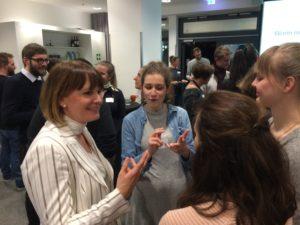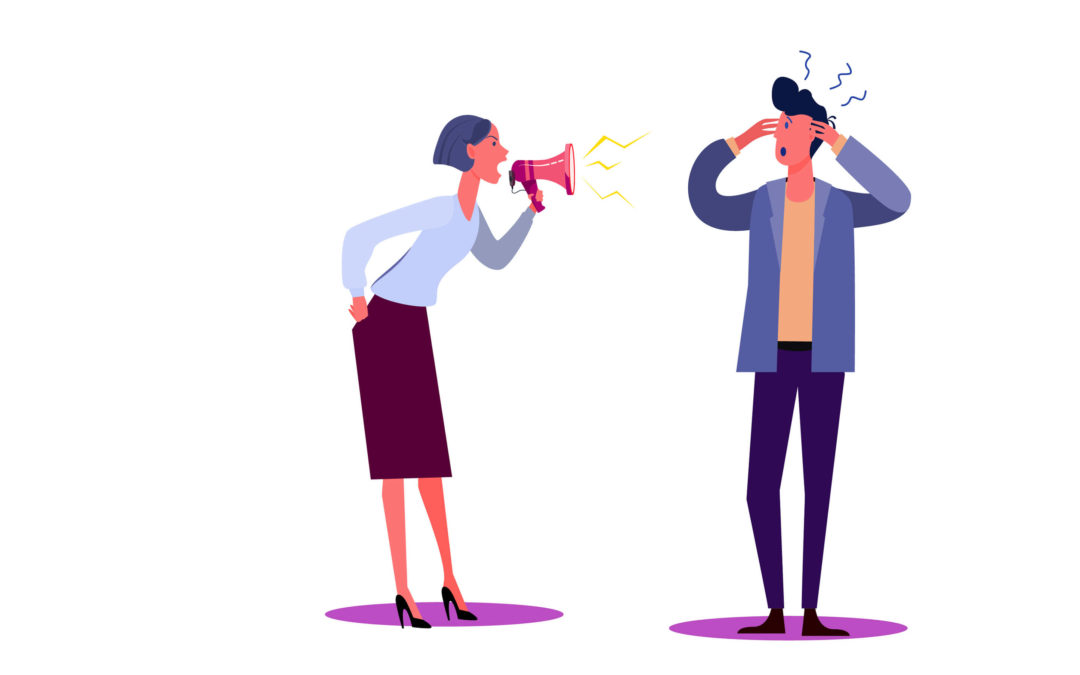This article has originally been published here (German).
Innovation happens when different opinions are heard and used, when teams learn to listen to each other and to work well together despite different perspectives. Innovation is not always created by overly happy people using rainbow-colored post-its in fancy offices. Often, innovation means to solve a conflict and to make new decisions based on the different perspectives, to break new ground. If you want to be innovative, you have to look and actively deal with different opinions. That can be exhausting. However, there is support: differences should not take center stage in a rigid and fixed manner. Therefore, ways of thinking and methods are needed that help to see conflicts as something positive and to use them constructively.

Heidi, Anna and Michael guide the meetup with various practical exercises
We wanted to know how to establish a good culture of conflict in modern organizations and use it as a driver of innovation. For this reason, we discussed this topic with 50 participants at the 27th New Work Berlin Meetup at DB mindbox on 20 February 2020. Together with our experts Anna Kader and Michael Heider (founders of emotional), as well as Heidi Dommaschke (mediator and trainer at hundred ways), we took an experimental approach to what constitutes good communication and what it has to do with a positive working environment.
Many companies are becoming increasingly aware of the importance of a work culture that can be shaped. Some follow the trend of a flat corporate hierarchy and build new freedom within existing systems. Others rely on collaborative mindsets and their effectiveness right from the start. Relationships change, we spend more time together beyond the work context and our language reflects this new awareness: we talk about mutual trust, look for employees who are passionate about their work and demand authenticity from our employer. And we communicate on different channels. So is everything fine?
Good communication doesn’t work without training
Often, despite our shared vision and purpose, we fall for the same communication problems as everywhere else where people meet. But now we may find it even more difficult to deal with conflicts where roles are no longer so clearly defined and the boundaries between collegiality and friendship are blurred. How are we supposed to meet in conflicts when the vocabulary alone has shifted towards emotionality?
Anna Kadar explains:
We have massively changed our working environment, but have simply skipped some essential steps in our personal development, for example: mindful communication. Luckily, this is a muscle that can and should be trained very well.
A culture of psychological security is the basis for more humanity in the workplace. If we move in a good and safe learning environment that is characterized by social empathy and a good culture of error, it is easier for us to show ourselves as we are. Trust enables creativity and effectiveness. At the same time, mindful and empathic communication is one of many means to create this environment. While it is clear that with so much diversity, conflicts can arise, it is unclear how we encounter them, how we resolve them and how we leverage them. In many cases, we simply have not learned how to do this. In times of digital change, the human element seems to lag behind sometimes.

In groups of two to five, our participants tried to make use of their consciousness
How to and how not to?
It is difficult to listen to the other person properly when your own idea or view seems to be the right one or when you have the solution for the other person’s problem directly at hand. We are solution-oriented – we want to work as quickly, effectively and straightforwardly as possible. And we overlook the chance of experiencing something new if we focus and pay full attention to the other person. After all, this is very uncomfortable when it is contrary to one’s own world view.
But pure awareness of these issues is not enough. How easily we fall out of an open, mindful attitude is quickly and mercilessly shown by everyday life. In order to train the muscle for empathic communication, three interactive exercises for two, four and a large group of people took place in the meetup, which allowed us to thoroughly rethink our conversation and conflict behavior. You are invited to use these in the next situation you encounter in your daily life.
MINI-TALKS
Get started by asking and reflecting on questions in short mini-talks: What skills are needed for a good debate culture? What do I want to improve in this respect?
We experience our behavior in conflict mainly as a reaction to the behavior of the other person. The well-known vicious circle takes its course: “I only did it because you… “. Using these questions and mini-talks helps us to take responsibility for our own actions instead of hiding behind accusations against the others.
INTERFERENCE OF CONVERSATION
To deepen our knowledge, we can check our very specific listening skills: Can I give the other person my full presence, attention and empathy? How do I do this best and how not?
Typical interferences of conversation include, for example, our beloved and well-meant advice and wisdom. Also generalizing, trivializing, moralizing, correcting, interrupting – all these things separate us in communication more than they connect us. In the end, the narrator is only frustrated. When paying attention to this, it quickly becomes clear how often this happens to us quite unintentionally and is part of our everyday communication.
DEEP LISTENING
Even more training of the deep muscles works well with Deep Listening: Do we actually pay attention to all the messages that are sent in a conversation and are we able to grasp and interpret them all? Five of us worked on the different components in this exercise: A narrator reports on a conflict he/she is dealing with. Four listeners mirror on four levels:
- What is the content of the narrative?
- Which facial expressions and gestures underline and accompany what is being said?
- What feelings and needs are probably behind the content?
- And what does the narrator want, what does he or she need?
Try this: In the next situation, dive deeply into what is being said, while at the same time taking in the surroundings, paying attention to these four levels. As with any training, this becomes easier with practice.
Mind Maps and Perspectives
At our meetup, we experienced and discussed intensively how complex communication can be. It helps to remember again and again that we all perceive something different from the world. The map in our mind is individually shaped, full of experiences, values and emotions. And we like to think of our perspective as the only reality. Getting involved with the other person and his mind map is the basis of empathy. Empathy creates an environment in which it will be easier to express your own opinion. Where this becomes easier, there is more exchange, more controversy and ultimately more learning. What does this mean for our culture of debate, for new work and innovation? Remain open to many new ideas and perspectives. Even if it is sometimes annoying.
Here are a few more links if you are still looking for ideas on the topic of a culture of conflict:
- Sociocracy – here we use tensions between roles in the organization to develop them continuously.
- Nonviolent communication – here authentic feelings are used to get in contact with each other. Feelings are not discriminated – both traditionally “positive feelings”, such as joy, and traditionally “negative feelings”, such as sadness, fear or anger, are seen as a gift that can bring people in better contact with each other.
- Liberating structures – A collection of structures that support the constructive use of diverse perspectives.
Our guest authors

Heidi Dommaschke
Heidi Dommaschke accompanies people and organizations in change as trainer, mediator and coach. In addition to inner work, resilience and resource development, she is particularly interested in the further development of communication and conflict competence. In doing so, she is concerned with the question of how we want to live and work, and how we can actively shape the world around us. https://www.hundred-ways.com

Conny Grünbaum
Conny Grünbaum is mainly responsible for personnel recruitment at the IT consultant Assecor. In an industry in which the lack of skilled workers is clearly noticeable, she regularly has to reflect what an attractive working environment for employees should look like and how it can be implemented for the company. What she values most about working in her company is the autonomy and freedom of decision that she enjoys for her tasks.

Jens Hündling – picture by studioafraz.com
Jens Hündling is a freelance trainer and coach for digital transformation and new work. As a former IT executive, he prefers to communicate with people rather than machines. Jens is passionate about developing teams and organizations. Especially with East Frisian humor. More about him at https://dr-huendling.de

